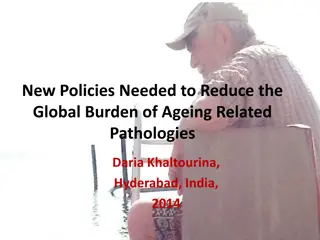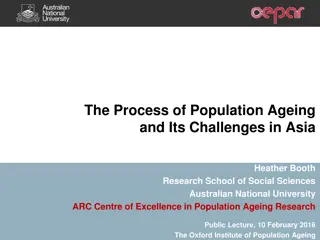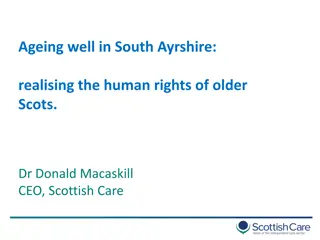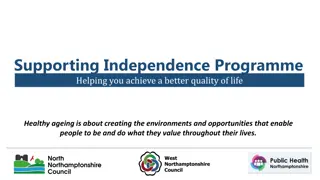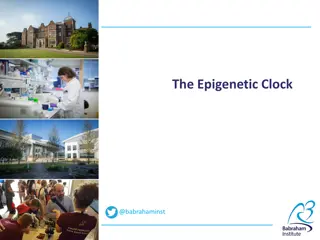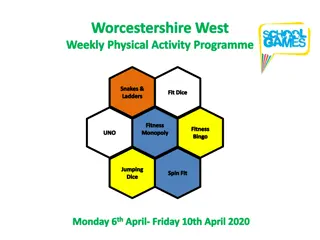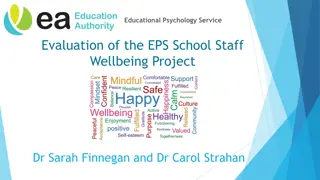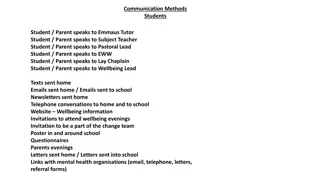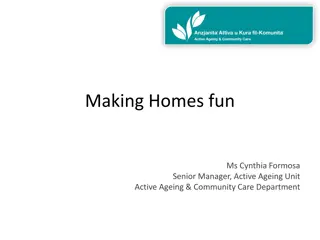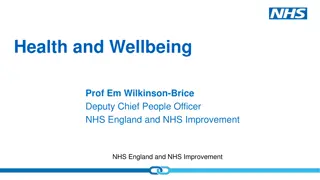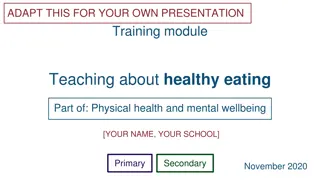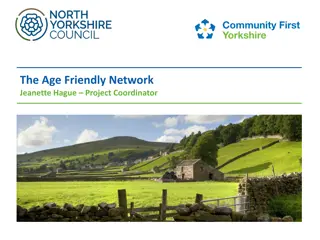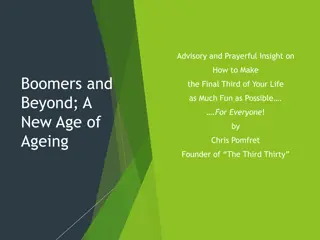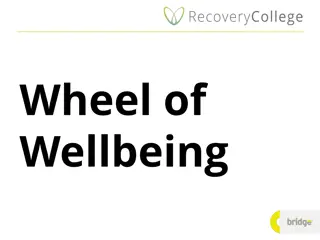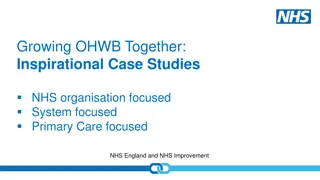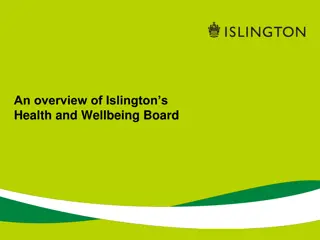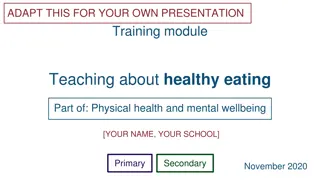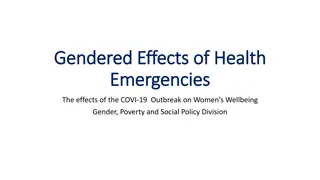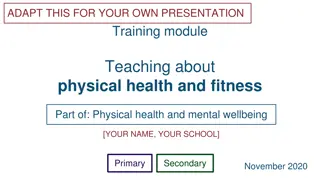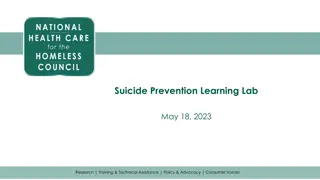Promoting Healthy Ageing and Wellbeing in Worcestershire: Key Messages and Workstreams
In Worcestershire, the focus is on promoting healthy ageing and wellbeing through various initiatives. Around 50% of people over 50 and 80% over 65 live with long-term conditions. The rise in older population is significant, with a focus on improving fitness and volunteer engagement. The LifeCurve project aims to delay functional decline in later life through different workstreams focusing on carers, domiciliary care, care homes, staff wellbeing, and resistance bands. Key messages emphasize living well, understanding one's LifeCurve, staying active, and accessing local resources for independent living.
Download Presentation

Please find below an Image/Link to download the presentation.
The content on the website is provided AS IS for your information and personal use only. It may not be sold, licensed, or shared on other websites without obtaining consent from the author. Download presentation by click this link. If you encounter any issues during the download, it is possible that the publisher has removed the file from their server.
E N D
Presentation Transcript
Email: laterlife@worcestershire.gov.uk #LaterLife #AgeingWell
Ageing Well Facts & Figures Ageing Well Facts & Figures The King s Fund estimates that around 50% of people aged over 50 and 80% of those over 65 live with one or more long-term conditions. The number of older people is predicted to increase by nearly 1/3 between 2019 and 2035 in Worcestershire. The rise is expected to be fastest in those aged 85 or over where the number is set to almost double (increase by 92%). (JSNA, 2019) Common decline in fitness starts at 30 and accelerates more rapidly after 45, this can be made worse if a person lives a sedentary lifestyle.(BMJ) Ratings of worthwhile werehighest, on average, for people aged between 65 to 74 and lowest for those aged 90 and above (ONS, 2016) 4.9M (58%) of 65 and overs volunteer or take part in civic engagement! Over a (27%) of those aged 55-74 and nearly (49%) of people aged 75+ are reported as being inactive. (Age UK / Sport England) In Worcestershire the life expectancy for a women is 83.9 with 16.7years spent in poor health, for a man it s 79.9 with 14.2 years spent in poor health. (JSNA, 2019) 65 to 80 year old's are by far the happiest group in societywith the lowest being those in mid life 45 to 54. (ONS, 2016) Older people provide more volunteer support than any other section of the population.. The value is estimated at around 10 billion pounds. (The 10 Steps of Positive Ageing) Muscle mass is lost at a rate of 1% per year from age 55 onwards. (BMJ) Between 2017 and 2035 there is projected to be an increase in the numbers of people aged 65 and over who are unable to manage at least one domestic task on their own in Worcestershire (JSNA / Poppi) Older people provide a considerable amount of social carefor other (mostly) older people, the economic value of this was estimated at 34 billion 1/3 of older people in Worcestershire are providing unpaid care for more than 50 hour per week. (The 10 Steps of Positive Ageing + JSNA)
Project Workstreams Introduction of the LifeCurve + Living Well in Later Life Worcestershire LifeCurve website Living Well in Later Life Worcestershire multimedia campaign The project also includes the following major workstreams: 1. Carers: Working with WAC s Carer group to promote wellbeing and delay functional decline with the LifeCurve 2. Domiciliary Care: Enabling Dom Care partners to utilise the LifeCurve with those they care for, increasing activity levels and delaying functional decline 3. Extra Care / Care Homes: Equipping care homes to digitally engage with LifeCurve and delay functional decline among residents 4. WCC Staff Wellbeing: Promoting healthy ageing and wellbeing to Worcestershire County Council s employees 5. Resistance Bands A series of resistance band pilots assessing the benefits in improving muscle strength and functional ability #LaterLife #AgeingWell
Our Key Messages: Our Key Messages: Living Well: Living Well: Access health and wellbeing information to help you live well Your LifeCurve: Your LifeCurve: Understand your LifeCurve and how to maintain or improve your position Keeping Active: Keeping Active: Keep active in later life with advice and exercise tailored to your ability In Your Area: In Your Area: Local activities, services and resources that support you to live independently #LaterLife #AgeingWell
What does What does living well in living well in later life later life mean? mean? Physical health / ability Fitness Mental Health / Self Care Spending time with friends and family Healthy eating Hobbies / meaningful activities Learning new skills Job satisfaction Sleeping well Having a routine Financial security Which do you think is the most important? Giving to others / volunteering Mindfulness Feeling safe Independence Giving up smoking Being a healthy weight Being a part of a local community #LaterLife #AgeingWell
Keeping Active Keeping Active Why is it important? Why is it important? It s important to keep physically and mentally active to slow down age related functional decline. To stay healthy all older adults should: Aim to be active daily doing at least 150 minutes of moderate aerobic activity such as cycling or fast walking every week On two or more days a week do strength exercises that work all major muscles Older adults at risk of falling should also do activities to improve balance and coordination on at least two days a week Functional decline and the need for social care are not inevitable consequences of ageing. 25% of women and 20% of men in the UK report doing no activity at all in a week, let alone the recommended minimum 150 minutes to maintain health. (BMJ, 2018) #LaterLife #AgeingWell
LifeCurve LifeCurve - What is the LifeCurve? Fitness and strength points Self-Assessment #LaterLife #AgeingWell
Living Well in Later Life Worcestershire Living Well in Later Life Worcestershire & LifeCurve Website: & LifeCurve Website: Two points of entry to LifeCurve self-assessment: 1. Living Well in Later Life Worcestershire Website The Living Well in Later Life Worcestershire website allows users to access the LifeCurve self-assessment, information, advice and resources. An individual can access support and information from the website even if they do not register with the LifeCurve and carry out a self assessment. 2. LifeCurve App When using the ADL LifeCurve App (i.e. smartphone / iPad / tablet) the user can connect with the Living Well in Later Life Worcestershire package with a link or QR code this will be prompted automatically based on the users postcode entry, allowing them to access the same information as those who enter via the website. #LaterLife #AgeingWell
LifeCurve Self-Assessment Carrying out a self-assessment The user can carry out a self-assessment on an app (on a smart phone, tablet or iPad), via the website on a computer or with help from a family member, friend or care worker if they do not have access to a device. The self-assessment will ask 19 quick questions based around physical abilities, the user will then be asked to create an account so they can track their progress and save your exercise and activity information. There are step-by-step guides on how to set carry out an assessment and set up an account. Who can see my information? If the user agrees to share their progress with us, WCC and ADL LifeCurve will be able to see their details. There is an option to remain anonymous. Full privacy information is available. 1 Phone via App 3 Computer via Web 2 Tablet via App #LaterLife #AgeingWell
LifeCurve App Journey Main self-assessment questions (15) User cannot go shopping without assistance Tailored exercises to regain ability to go shopping Fitness and strength points (4) #LaterLife #AgeingWell
LifeCurve App User Journey Video #LaterLife #AgeingWell
LifeCurve - In Your Area Mapping and signposting to local resources: District based offerings Access / contacts for support Community services and groups Local assets e.g. green spaces Source: BarbedWyre.com #LaterLife #AgeingWell
LifeCurve - Benefits Improved wellbeing for older people and those supporting them Simple self-assessment can be completed by an older person, family member, friend or carer Participants LiveCurve position improves increasing activity and enabling them to do things that they could not previously do One point of access to resources, advice and services Tailored activities Insight into LifeCurve users position, interventions and progress Unified system wide approach to promoting active / healthy ageing Reduction in demand on services and social care costs #LaterLife #AgeingWell
Resistance Bands Purchase of 32,000 branded resistance bands (over three years) for a series of pilots assessing the benefits in improving muscle strength and functional ability. Promote the use of resistance bands as a self-motivating tool to engage with all sections of the community. Opportunities for pilots with: University of Worcester Active Ageing Active H&W Acute Physios Discharge bundles Carers VCS partners Care homes Areas of highest need To include: Resistance band Exercise booklet Video tutorial Use of video conferencing (i.e. Zoom) for sessions Measurement: Grip test Get up and go test Surveys #LaterLife #AgeingWell
Comms & Engagement Living Well in Later Life Worcestershire multimedia campaign to promote key messages across the county (Public Health, WCC and ICOPE social media accounts) ICOPE branded promotional materials Ageing Well Toolkits & Information Packs: Partner, LifeCurve user, resistance band participants Focused engagement for areas of highest need and digitally excluded Engaging with partners and potential partners online forum, meetings & quarterly partner newsletter Feedback / Surveys #LaterLife #AgeingWell
Email: laterlife@worcestershire.gov.uk #LaterLife #AgeingWell




